2024 NFL draft rankings: Caleb Williams, Marvin Harrison Jr. lead top 50 players
With just two weeks left until the start of the first round, the 2024 NFL draft will soon flip from projecting to selecting.
As difficult as it is to forecast how teams will use their top picks, stacking up the best prospects can be an equally treacherous exercise. But let's embrace the uncertainty of comparing players at different positions and examine where the biggest names stand in terms of value rather than expected draft slot.
While the quarterbacks will command the spotlight, the receivers might be the true standouts. The top three pass catchers all look bound to fly off the board early, and 13 players at the position made the cut for our top 50 big board. Not far behind are the offensive tackles and cornerbacks, with each premium position boasting eight in our rankings. And the signal-callers ended up with six players inside the top 40, including four in the top 20 and three in the first 10.
Here's USA TODAY Sports' 2024 NFL draft prospect rankings:
1. Caleb Williams, QB, USC
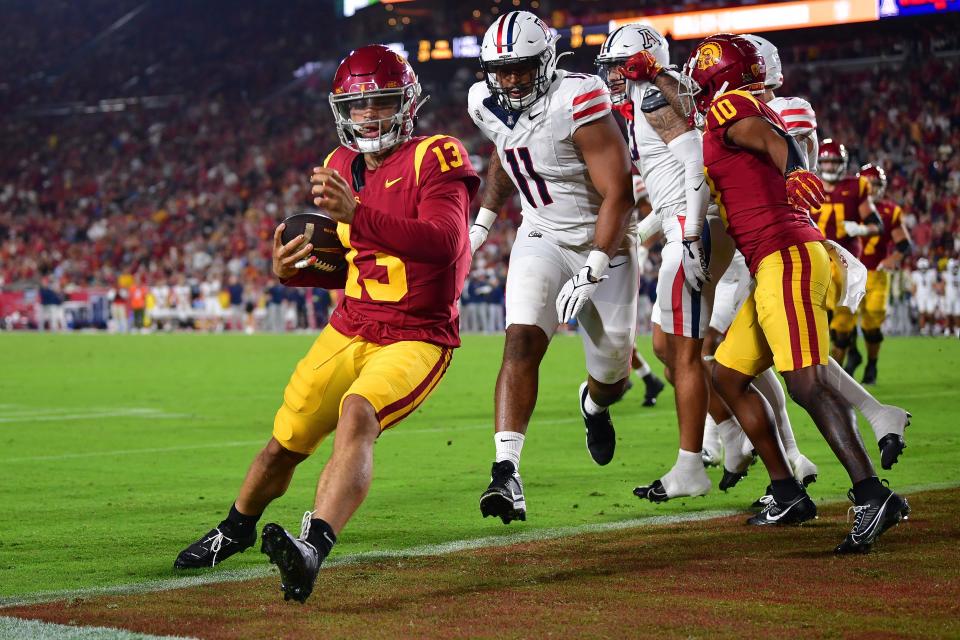
It's impossible to discuss the 2022 Heisman Trophy winner without starting with his creativity. For some, the escape-artist highlights and signature deep strikes are the primary selling points for Williams, one of the most heavily anticipated draft prospects in some time. Yet a good portion of what makes the 6-1, 214-pounder so alluring is rooted in basic tenets of good quarterback play: calm footwork, pinpoint accuracy and exceptional awareness. While his proclivity for always seeking out big gains as he holds onto the ball looks untenable in the long term, Williams can be a truly elite offensive catalyst once he proves he can play on schedule and take advantage of the easy throws afforded to him.
2. Marvin Harrison Jr., WR, Ohio State
What's left to say about a two-time unanimous All-American who somehow managed to live up to the expectations that inherently come from playing the same position as his Hall of Fame father? Harrison Jr. is a strong candidate for this class' most complete prospect, as the 6-3, 209-pounder brings together so many exceptional traits while raising so few concerns. His expert route-running, world-class body control and commanding ball skills should position him to be massively productive early in his career.
3. Rome Odunze, WR, Washington
No one dominates on contested catches quite like Odunze, who said at the combine he views all 50/50 balls as "100/0" in his favor. The 6-3, 212-pound wideout should become a fast favorite of his next coaching staff, as he can haul in circus catches to bail out his quarterback and brings an extremely well-rounded skill set to any passing attack. He has more than enough burst and polish as a route runner, too, to get open consistently.
4. Malik Nabers, WR, LSU
Merely getting into the orbit of past LSU receiving greats should be considered a success for any Tiger product, but Nabers somehow managed to top the impossibly high standards set by his predecessors, finishing as the school's all-time leader in receptions (189) and receiving yards (3,003). Separation comes easy to the 6-0, 200-pound target, whether it's racing past cornerbacks on deep balls or slicing his way through the defense after the catch. Nabers' still-developing route-running leaves him a tick behind Harrison Jr. and Odunze, but he would be the No. 1 receiver in almost any other class – and he still might eventually end up with that title.
5. Drake Maye, QB, North Carolina
The massive gap between how dazzling Maye can be at his best and how unpalatable his play is at his worst leaves a perplexing picture of a quarterback. Right now, however, the upshot is relatively simple: Maye is volatile both as a passer and a projection. Ultimately, few college quarterbacks in recent years have been able to take control of a game the way the 6-4, 223-pounder can with one of his downfield darts or throws made on the move. That unique aptitude only goes so far if problems with ball placement and decision-making persist, but it's hard to shake the possibilities Maye can open up for any offense.
6. Brock Bowers, TE, Georgia
The only two-time Mackey Award winner leaves college football as arguably its most accomplished tight end of all time. While the NFL's spotty history of evaluating players at the position might leave some uneasy about using a premium pick on Bowers, all it should take to calm his future team is taking another look at his on-field work. He's at his best after the catch, as he can pull away from would-be tacklers or merely toss them aside. The comparisons to George Kittle might be lofty, but Bowers figures to be the rare tight end who can recalibrate an offense.
7. Jayden Daniels, QB, LSU
The unquestionable breakout player of 2023, Daniels took an enormous leap in his development to become last season's Heisman Trophy winner and one of college football's most electric offensive threats. Despite vexing defenses as a runner with 1,134 rushing yards last season, Daniels is perfectly content to pick apart opponents from the pocket with his cool and composed approach. Deep passes, however, won't come as easily given his pedestrian velocity, and he'll have to learn how to work between the numbers more often while also speeding up his processing. Coaches also might be on edge about how his 6-4, 210-pound frame will hold up, especially given how frequently he subjects himself to big hits.
8. Joe Alt, OT, Notre Dame
In a deep class of towering offensive tackles, Alt stands above them all – literally. At 6-9 and 321 pounds, the son of former Chiefs lineman John Alt offers few avenues for defenders to disrupt plays, utilizing his superlative footwork and feel for the position to keep pass rushers at bay. He's more efficient than downright dominant, and problems with leverage and balance will require attention, but Alt's overall athleticism and intelligence make him an easy top-10 pick.
9. Quinyon Mitchell, CB, Toledo
Don't fret about the level of competition. The 6-0, 195-pounder has all the traits of a top-flight cornerback, with a preternatural sense for finding the ball in the air. He can hold up in either zone coverage or man, though he'll likely need more reps in the latter, particularly when asked to press.
10. Terrion Arnold, CB, Alabama
Not many cornerbacks can toggle between outside and the slot while handling a broad range of receivers, but Arnold sizes up as the rare figure who can be trusted in almost any matchup. The 6-0, 189-pounder is both sticky in coverage and pesky at the catch point, though his aggressive nature could be exploited by crafty, patient receivers in the early going.
11. Jared Verse, DE, Florida State
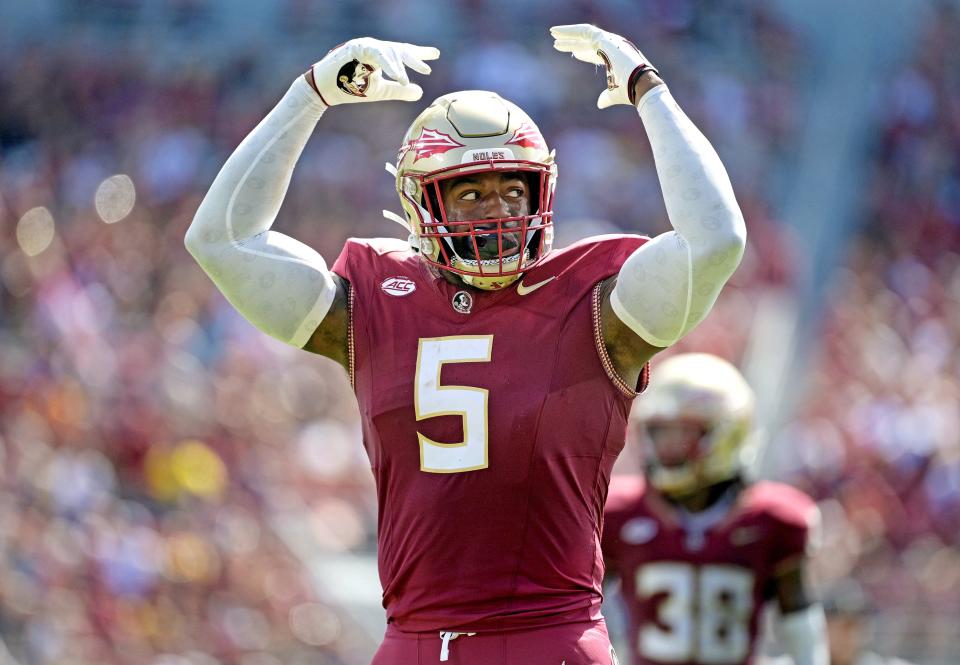
The Albany transfer brings a throwback demeanor to the position, frequently attacking offensive tackles by jolting them as soon as he can get them on their heels. The 6-4, 254-pounder's limited bend might put a ceiling on his potential sack production, but he has the tools to create consistent pressure.
12. Dallas Turner, OLB, Alabama
Following in the footsteps of former teammate Will Anderson Jr., Turner took over the mantle of Alabama's next premier pass rusher and became the Southeastern Conference Defensive Player of the Year and a consensus All-American. While the 6-3, 247-pounder's pass rush plan and instincts aren't as developed as those of the reigning NFL Defensive Rookie of the Year, Turner offers a tantalizing blend of length and burst that should prove difficult for opposing linemen to answer for.
13. Troy Fautanu, OT/G, Washington
His height (6-4) and anchor might be the only significant limiting factors for a blocker who likely could step into any position along the line and flourish early in his career. Everything Fautanu does is fast and aggressive, though that mindset can occasionally get him in trouble.
14. Byron Murphy II, DT, Texas
Amid a booming market for highly disruptive interior linemen, Murphy steps into the NFL as perhaps the next great undersized defensive tackle. Any defense eager to upgrade its pass rush should be able to look past his 6-1, 297-pound build and instead focus on the havoc he can create with his quick-twitch moves.
15. Olumuyiwa Fashanu, OT, Penn State
There simply aren't many 6-6, 312-pound offensive tackles who demonstrate the foot speed and balance to handle all the rigors of pass protection in the NFL, so the interest in an ascending player who will be 21 for most of his rookie year isn't hard to figure out. The question for Fashanu is how quickly he can be trusted to handle the role of blindside blocker given his lapses, particularly in leaving himself vulnerable to inside countermoves.
16. JC Latham, OT, Alabama
When Latham can get his hands on an opponent, it's typically game over. The 6-6, 342-pounder locks out linemen with his sheer strength, though his footwork also easily outpaces expectations for a player of his size. Some refinement is still required, but experience and coaching should iron out his most pressing issues.
17. J.J. McCarthy, QB, Michigan
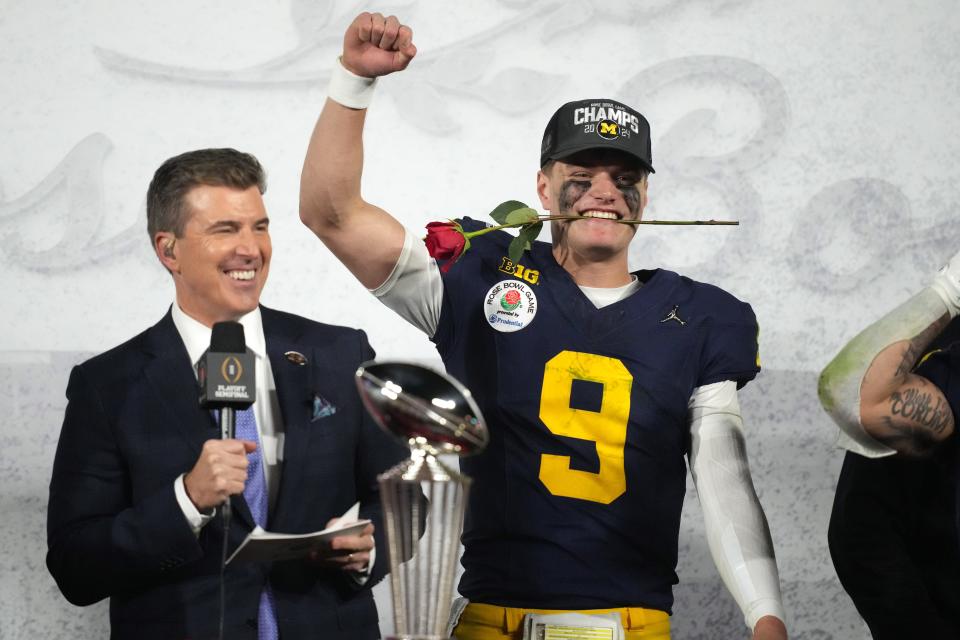
The NFL draft's ultimate mystery box is somehow a two-year starter for the reigning national champions. McCarthy lacks the other-worldly physical traits and creativity that typically vault quarterbacks into the top five picks of the draft, but there's still reason to believe that there's another level within reach for the 6-3, 219-pound passer. Becoming a quicker and more reliable decision-maker might be the key factor for a player whose game likely will stay rooted in efficiency rather than a high volume of splash plays.
18. Laiatu Latu, DE, UCLA
Equipped with a pass-rush arsenal far more varied and advanced than his peers, Latu sets himself apart as easily the most pro-ready edge defender in this class. That technical prowess could take him far, which might be vital for the 6-5, 259-pounder given his pedestrian length, speed and power. His medical outlook could also be an X-factor for his draft stock after he medically retired at Washington due to a neck ailment.
19. Cooper DeJean, CB, Iowa
For better or worse, DeJean has achieved outlier status due to his burly 6-1, 203-pound build more fitting of a safety. Leveraging his seldom-seen size, speed and ball skills by keeping him at outside cornerback still seems like the right move, though teams might look for other ways to tap into his explosiveness that's more linear than fluid.
20. Adonai Mitchell, WR, Texas
At 6-2 and 205 pounds with 4.34-second speed in the 40-yard dash, Mitchell might come across as a pure straight-line, downfield threat. The Georgia transfer's calling card, however, is the fluidity he shows off when easily shaking defenders on his breaks. If he becomes more physical at the catch point, he could become an imposing No. 1 receiver.
21. Taliese Fuaga, OT, Oregon State
Anyone who tests Fuaga is bound to pay for it, as the 6-6, 324-pounder plays as though he's looking to dole out punishment. Though his mauling demeanor in the run game might push some teams to ponder him at guard, he can be an above average pass protector at right tackle.
22. Graham Barton, G/C, Duke
A left tackle the last three seasons after beginning his career as a center, Barton looks ticketed for a move back inside to protect him from matchups against the NFL's rangiest and most explosive pass rushers. His savvy should come in handy on the interior, however, as the 6-5, 311-pounder figures to be an aggressive yet composed blocker who can set the tone for an entire line.
23. Chop Robinson, DE/OLB, Penn State
A terror from his first step, Robinson poses a massive problem for any blocker who can't move quickly enough to keep the 6-3, 254-pounder from firing around the edge. His production and hand usage are underwhelming, but the untapped potential is hard to ignore.
24. Amarius Mims, OT, Georgia
A 6-8, 340-pound offensive tackle who is a smooth mover and shows impressive flexibility sounds like an offensive line coach's pipe dream. Mims brings that package together, but with just eight starts in his career, his development is severely lagging.
25. Brian Thomas Jr., WR, LSU
Boasting a Football Bowl Subdivision-best 17 touchdowns while averaging 17.3 yards per catch, the 6-3, 209-pounder with 4.34 speed in the 40 is a big play waiting to happen. Rounding into something more than a mere deep threat will depend on him becoming a more nuanced route runner and proving he can hold up over the middle of the field.
26. Nate Wiggins, CB, Clemson
A 6-1 cornerback who can rip off a 4.28-second 40-yard dash shouldn't require a hard sell for any defense looking to put the clamps on any deep passes. Wiggins' 178-pound frame could be a significant hindrance when he faces more physical receivers and tries to be a factor against the run, but any team buying in will be primarily focused on the impressive coverage toolkit.
27. Ladd McConkey, WR, Georgia
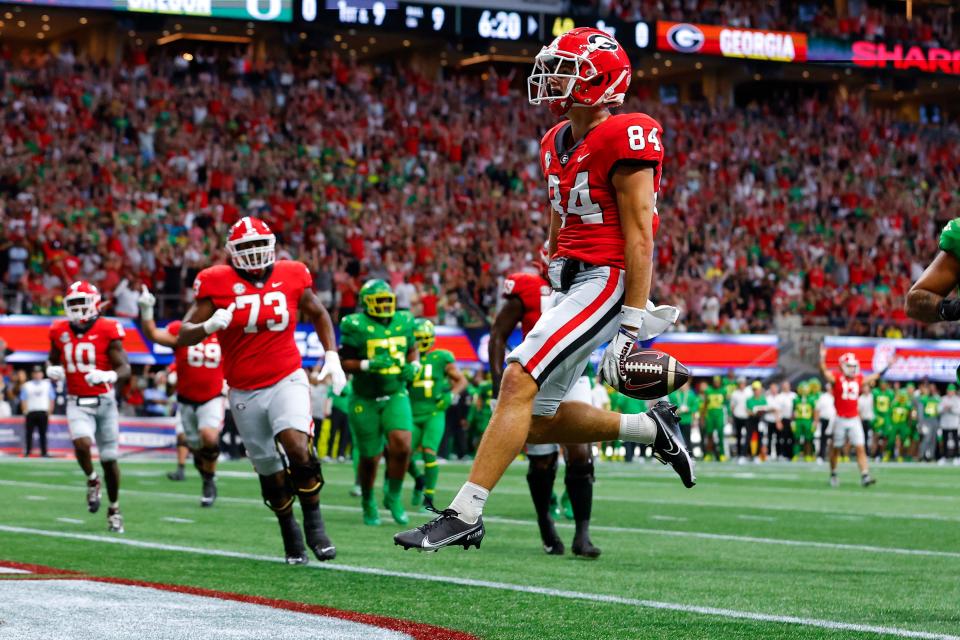
Dismiss him as a mere slot receiver at your own peril. McConkey masterfully sets up defensive backs to break himself free of coverage at every level, and he has enough juice as a deep threat to force defenses to stay honest. Expect him to take on a significant role as a trustworthy weapon who can keep an offense rolling with his work on intermediate routes.
28. Jordan Morgan, OT/G, Arizona
Morgan might be the forgotten man among this year's bevy of potential first-round offensive linemen, but his fleet feet and impressive knowhow position him as a strong candidate to make the Day 1 cut. While some teams could be inclined to move him to guard, the 6-5, 311-pounder shows the effectiveness in space to stick at left tackle with some additional work.
29. Johnny Newton, DT, Illinois
The reigning Big Ten Defensive Player of the Year stands at a modest 6-2 and 304 pounds, but his track record of disruption speaks for itself. Though Newton relies on a slippery, persistent approach to beat blockers that might not be as consistently effective in the pros, his craftiness should unlock different ways for him to snake into the backfield.
30. Kool-Aid McKinstry, CB, Alabama
Steady and savvy, McKinstry is one of this class' most reliable defensive prospects. While he's not as dynamic as other cornerbacks, his well-rounded physical tools and outstanding recognition give him a high floor as someone who can be trusted to handle a variety of coverage assignments.
31. Bo Nix, QB, Oregon
On one hand, a quarterback with a FBS-record 61 starts seems very much like a known entity, with the Auburn transfer exhibiting the kind of recognition and command one would expect from a signal-caller with his extensive experience. On the other, Nix remains somewhat of a conundrum due to an Oregon offense that afforded him ample easy looks, with a good chunk of his production coming on throws behind the line of scrimmage. As a 24-year-old whose downfield passing is a work in progress, Nix might spark questions about how much room for growth he truly has left. But his skill set could prove alluring to teams in search of a starter.
32. Payton Wilson, LB, North Carolina State
It's impossible to discuss Wilson's draft fate without acknowledging an extensive injury history that includes twice tearing the same ACL and surgery on both shoulders. But when healthy, the 6-4, 233-pounder can be a force in space, as the Bednarik Award winner demonstrated last season.
33. Tyler Guyton, OT, Oklahoma
Lots to like about the upside of a 6-8, 322-pound former H-back, whose frame and movement skills might have some imagining a future cornerstone pass protector. But there's also significant work to be done on his technique, leaving Guyton as a potential boom-or-bust blocker.
34. Jackson Powers-Johnson, C, Oregon
Rocketing onto the scene in his lone season as a starter, Powers-Johnson won the Rimington Award and was a unanimous All-American. Though he could also play guard, his punishing play screams solid starter at center.
35. Troy Franklin, WR, Oregon
Any team looking to open up its offense might gravitate toward Franklin, who will make his living picking up yardage in chunks on deep shots. The 6-2, 176-pounder can mix in some quick hits for run-after-catch opportunities, but he likely will be more of a complementary piece in a passing attack rather than a focal point.
36. Michael Penix Jr., QB, Washington
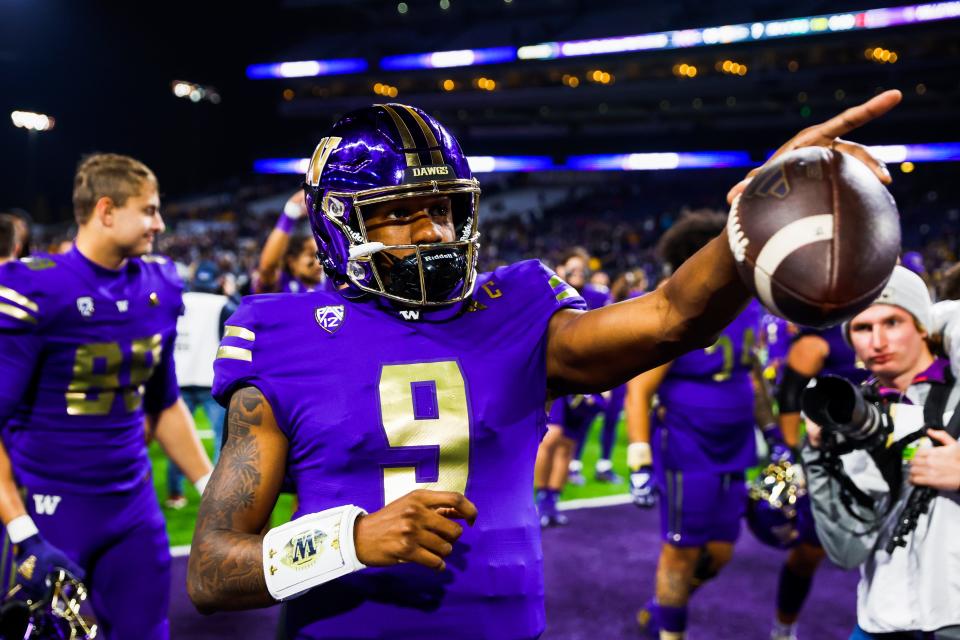
Ripping deep passes from the pocket comes easily to Penix, whose attacking mindset helped the Heisman Trophy runner-up lead Washington to the College Football Playoff national championship game. Yet things can get dicey when he's forced off his spot or tries to operate over the middle, with his ball placement occasionally veering toward wildly erratic. A quarterback who will turn 24 in May and has already suffered four season-ending injuries - two torn anterior cruciate ligaments and two shoulder ailments - won't be the right fit for every team. With the right supporting cast and scheme, however, Penix could be an intriguing option behind center.
37. Malachi Corley, WR, Western Kentucky
The Deebo Samuel comparisons are simultaneous understandable yet unfair for the "YAC King," one of college football's premier threats with the ball in his hands. Expanding his repertoire to become a more reliable downfield target – particularly on contested catches – will be a vital factor in determining whether he grows into a complete receiver or is limited to a gadget role.
38. Zach Frazier, C, West Virginia
A four-time state wrestling champion in high school, Frazier's background is evident on every snap. He's bound to drive defenders when he locks onto them, though lengthier linemen could give him some problems given his short arms.
39. Edgerrin Cooper, LB, Texas A&M
Few defenders in this class can match Cooper when it comes to chasing down the ball. To become a consistent force at the second level, however, the 6-2, 230-pounder needs to hone his instincts and not let his aggressiveness take him out of plays so frequently.
40. Keon Coleman, WR, Florida State
Concerns about his ability to separate have dogged Coleman throughout the pre-draft process. The Michigan State transfer, however, still makes his mark as a dependable jump-ball winner who can box out smaller defensive backs and be a major red-zone asset.
41. Ja'Tavion Sanders, TE, Texas
The 6-4, 245-pounder looks bound to follow many other college tight ends in essentially becoming a supersized receiver who is most often split wide and asked to do little as a blocker. That role should still leave him plenty of opportunities to make his mark, however, as Sanders can create mismatches all over the field in the passing game.
42. Roman Wilson, WR, Michigan
Limited looks in Michigan's offense didn't obscure his big-play ability, which keyed his 16.4 yards per catch and 12 touchdowns on 48 catches. The 5-11, 185-pound target should continue to tax defenses with his acceleration and a toughness typically not seen from receivers of his build.
43. Jermaine Burton, WR, Alabama
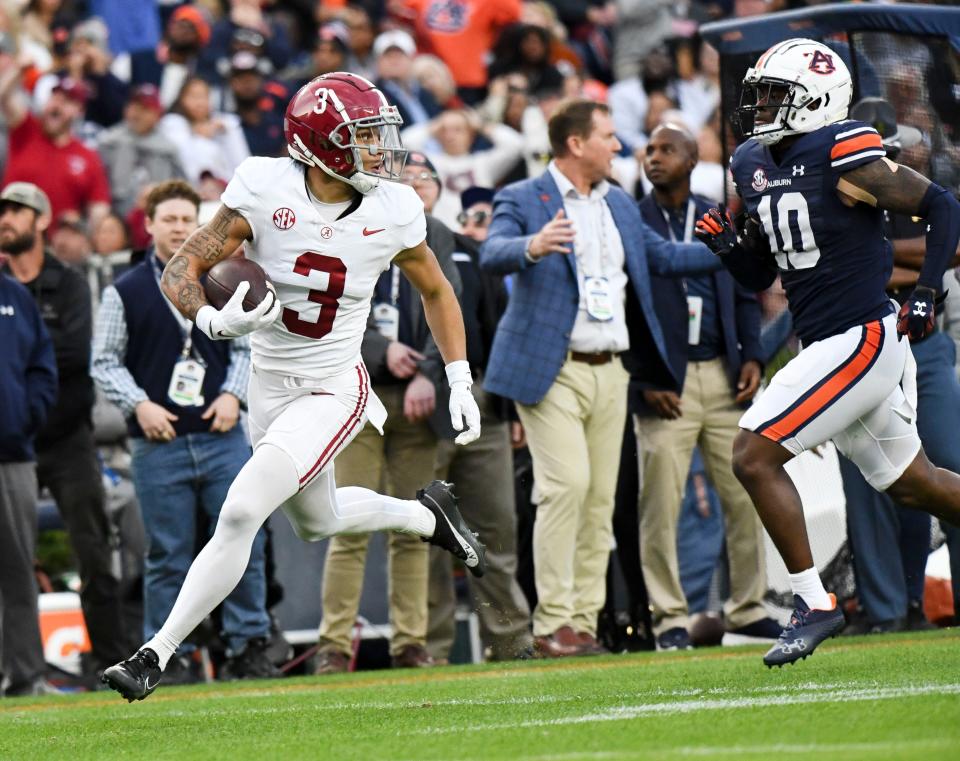
Even though he led the Crimson Tide in receiving yards the last two seasons, the Georgia transfer's production never seemed to measure up to his potential. That shouldn't dissuade teams from taking a look long at a target with an impressive blend of quickness, toughness and polish.
44. Kamari Lassiter, CB, Georgia
Hypercompetitive yet calm, Lassiter is the kind of determined coverage presence who can find his way in any scheme. Though his ball skills and overall athleticism aren't optimal, he can be a steadying addition to a secondary.
45. Junior Colson, LB, Michigan
Comfortable both in plugging the run game and dropping back in coverage, Colson can stay on the field in a variety of scenarios. The 6-2, 238-pounder depends more on functionality than flash, so speeding up his diagnosing skills will be key to his pro success.
46. Braden Fiske, DT, Florida State
When the 6-4, 292-pound transfer from Western Michigan sees an opening, he routinely shoots the gap and tracks down the ball. Holding up at the point of attack can be a struggle, however, so Fiske will only be a fit for teams prepared to unleash his attacking style.
47. Ricky Pearsall, WR, Florida
With his crisp routes, reliable hands and impressive body control, Pearsall should quickly endear himself to his future quarterback as a highly efficient slot weapon. Though he posted some explosive marks at the combine (4.41-second 40-yard dash, 42-inch vertical leap), he likely will be relegated to a short-to-intermediate target unless he proves he can consistently beat press coverage and create separation downfield.
48. T.J. Tampa, CB, Iowa State
At 6-1 and 189 pounds, Tampa has the tools and mentality to drape himself around receivers at the line of scrimmage and catch point. His long speed could leave him vulnerable in some matchups, but he could thrive as a playmaker in zone coverage.
49. Xavier Worthy, WR, Texas
With his record 4.21-second speed in the 40-yard dash, Worthy will arrive in the NFL as someone defenses will need to account for from Day 1, given how easily he can burn teams as a deep threat. But consistently beating press coverage and holding up at the catch point could prove to be major stumbling blocks for the 5-11, 165-pounder, who still struggles with drops despite making progress last season.
50. Max Melton, CB, Rutgers
The younger brother of Green Bay Packers wide receiver Bo Melton had no trouble making a name for himself on the other side of the ball for the Scarlet Knights. Teams able to deploy him in off coverage should be drawn to his penchant for finding the ball when he's allowed to work downhill.
This article originally appeared on USA TODAY: 2024 NFL draft rankings: Top 50 players, featuring six quarterbacks

